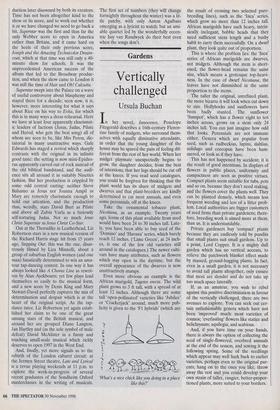Gardens
Vertically challenged
Ursula Buchan
In her novel, Innocence, Penelope Fitzgerald describes a 16th-century Floren- tine family of midgets, who surround them- selves with equally diminutive attendants, in order that the young daughter of the house may be spared the pain of feeling dif- ferent from the rest of her world. When her midget playmate unexpectedly begins to grow, the daughter decides, from the best of intentions, that her legs should be cut off at the knees. If you read seed catalogues, you could be forgiven for thinking that the plant world has its share of midgets and dwarves and that plant-breeders are kindly determined to cut most annuals, and even some perennials, off at the knees.
Take the ornamental tobacco plant, Nicotiana, as an example. Twenty years ago, forms of this plant available from seed would have been 24 to 30 inches tall. Late- ly, you have been able to buy seed of the 'Domino' and 'Havana' series, which barely reach 12 inches. Mime Green', at 24 inch- es, is one of the few old varieties still around in the catalogues.) The newer culti- vars have many attributes, such as flowers which stay open in the daytime, but the overall appearance of the dwarves is now unattractively stumpy.
Even more obvious an example is the African marigold, Tagetes erecta . The wild plant grows to 3 ft tall, with a spread of at least 12 inches. Although there are some tall 'open-pollinated' varieties like 'Jubilee' or 'Crackerjack' around, much more pub- licity is given to the 'Fl hybrids' (which are 'What's a nice chick like you doing in a place like this?' the result of crossing two selected pure- breeding lines), such as the 'Inca' series, which grow no more than 12 inches tall. African marigolds have such heavy, intrin- sically inelegant, bobble heads that they need sufficient stem length and a bushy habit to carry them successfully. On a dwarf plant, they look quite out of proportion.
This is where the problem lies: the 'Inca' series of African marigolds are dwarves, not midgets. Although the stem is short- ened, the flower-head remains the same size, which means a grotesque top-heavi- ness. In the case of dwarf Nicotiana, the leaves have not diminished in the same proportion to the stems.
The taller the original, unrefined plant, the more bizarre it will look when cut down to size. Hollyhocks and sunflowers have been badly stunted. The sunflower 'Sunspot', which has a flower eight to ten inches across, grows on a stem only 24 inches tall. You can just imagine how odd that looks. Perennials are not immune either. Genera which are popular from seed, such as rudbecIdas, lupins, dahlias, solidago and coreopsis have been ham- mered, or look as if they have.
This has not happened by accident; it is the result of good intentions. In displays of flowers in public places, uniformity and compactness are seen as positive virtues. Compact plants seem suitable for tubs, pots and so on, because they don't need staking, and the flowers cover the plants well. They can be planted densely, which means less frequent weeding and less of a litter prob- lem. Local authorities are bigger customers of seed firms than private gardeners; there- fore, breeding work is aimed more at them, than us. It is understandable.
Private gardeners buy 'compact' plants because they are endlessly told by pundits that small plants suit small gardens. Up to a point, Lord Copper. It is a mighty dull garden which has no vertical accents, to relieve the patchwork blanket effect made by massed, ground-hugging plants. In fact, even in a small garden, it is not necessary to avoid tall plants altogether, only ensure that most are slender and do not take up too much space laterally.
If, as an amateur, you wish to rebel against this positive discrimination in favour of the vertically challenged, there are two avenues to explore. You can seek out cer- tain unfashionable genera which have not been 'improved' much: most varieties of cosmos; 'everlasting' flowers like statice and helichrysum; aquilegia; and scabious.
And, if you have time on your hands, there is always the option of collecting the seed of single-flowered, overbred annuals at the end of the season, and sowing it the following spring. Some of the seedlings which appear may well hark back to earlier varieties, perhaps even to the original par- ents; hang on to the ones you like, throw away the rest and you could develop your own strain of taller, rangier, better-propor- tioned plants, more suited to your borders.


















































































 Previous page
Previous page